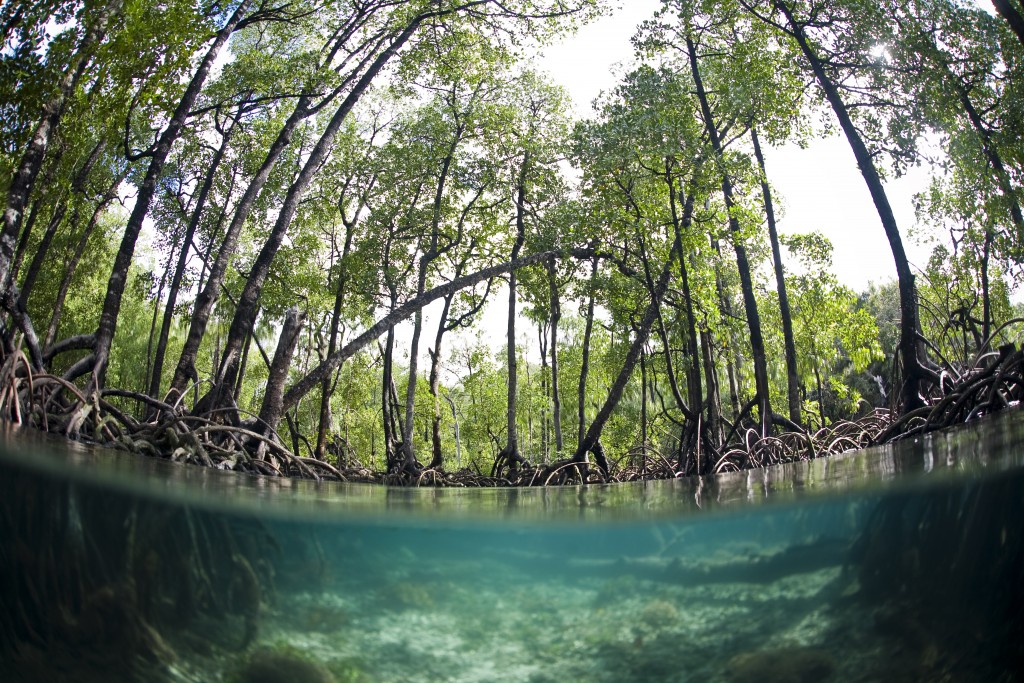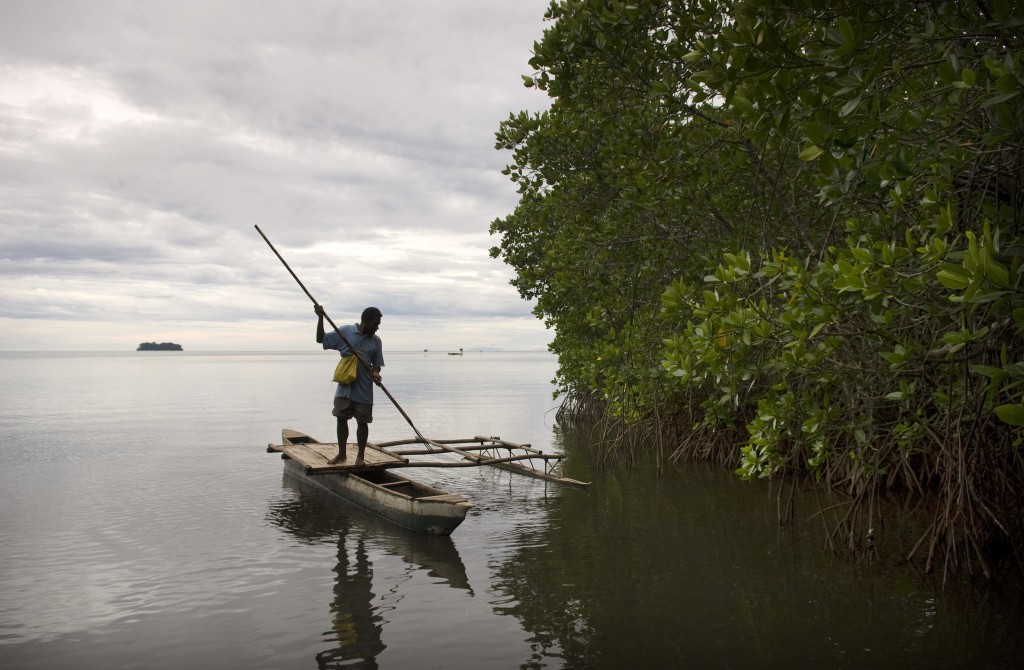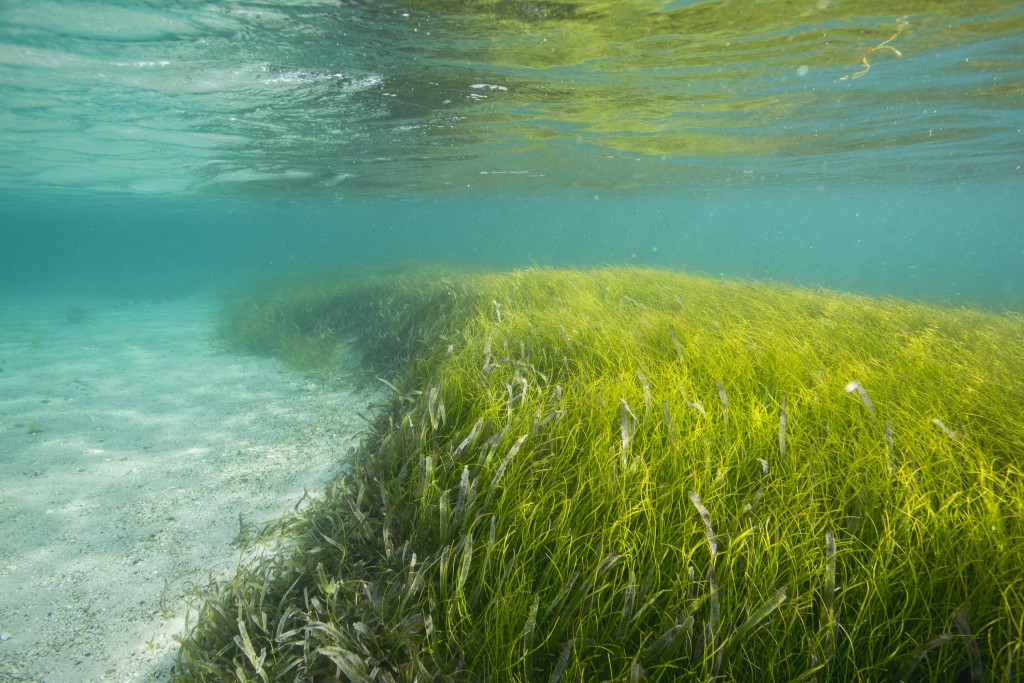Blue Carbon Projects
What is a Blue Carbon Project?
Blue carbon ecosystems can help to reduce climate change impacts, support adaptation, and secure social, economic, and environmental outcomes. Healthy, blue carbon ecosystems store and sequester carbon helping to mitigate climate change, support biodiversity, and provide valuable ecosystem services to coastal communities. When degraded or lost, they contribute to climate change by releasing stored greenhouse gases (GHG) into the atmosphere and can become significant emission sources.

Blue carbon projects can help countries reach their Nationally Determined Contribution (NDC) climate mitigation and adaptation objectives. Photo © Ethan Daniels
A blue carbon project uses the climate change mitigation value of marine and coastal ecosystems to support their conservation, sustainable use, and restoration. ref
Climate mitigation benefits of a blue carbon project are determined by comparing the changes in GHG reductions and emissions as a result of the project to the GHG reductions and emissions which would have occurred in the absence of the project.
Why do one?
Blue carbon projects can help national governments and communities to achieve multiple goals that include: climate mitigation and adaptation, sustainable livelihoods, conservation, and restoration of blue carbon ecosystems.
Blue carbon projects can help governments to deliver on their national mitigation and adaptation targets and commitments to meet environmental and sustainable development goals. They can support national efforts to calculate the ecosystem services of coastal environments, thus providing additional incentives for improved ecosystem management. They can provide additional financing to support existing environmental management strategies. For example, carbon offsetting can be used to generate funding for conservation by allowing an entity to purchase the ability to compensate for their carbon pollution in exchange for carbon not being emitted elsewhere – thus blue carbon ecosystems are kept intact, restored, or managed to secure and increase their carbon stocks. See an example of a project in Madagascar to support community livelihoods and carbon mitigation.
At the local level, blue carbon projects can directly improve the livelihoods of coastal communities by providing income, subsistence resources, and additional benefits (e.g., coastal protection provided by intact wetlands).

Protection of coral reefs, mangrove coastline, and biodiversity also protects sustainable fishing and livelihoods. Photo © Mark Godfrey
Improved management of blue carbon ecosystems, therefore, can enhance food security, secure livelihoods, increase resilience and contribute to delivering Nationally Determined Contributions (NDCs) through carbon sequestration and adaptation.
Examples of Blue Carbon Projects
Conservation of Intact Wetlands
Wetland soils are significant carbon stores, thus preventing wetland drainage and degradation can prevent large emissions of CO2. Project activities may include: controlling sources of stress (coastal pollution, overharvest, and coastal development) and working with land-use planners, tourism agencies, and communities to ensure existing blue carbon ecosystems are protected, and development is targeted away from vulnerable areas, habitats with significant carbon stocks, and habitats which provide other important human benefits (e.g., coastal protection, fisheries).
Restoration and Creation of Vegetated Wetlands
Project activities may include:
- Lowering water levels on impounded former wetlands
- Removing tidal barriers
- Rewetting of drained wetlands
- Raising soil surfaces with dredged material
- Increasing sediment supply by removing dams
- Restoring salinity conditions (reducing CH4 emissions)
- Improving water quality, e.g., for seagrasses
- Wetland or seagrass creation – converting land or marine areas from non-wetland to wetland or non-seagrass to seagrass habitat where there was previously no wetland/seagrass in existence

Coastal blue carbon ecosystems, such as seagrasses, play a critical role in the sequestration and long-term storage of carbon. Photo © Tim Calver
Guidance has been established to support the development of blue carbon projects (e.g., ref), and gender mainstreaming should be a fundamental component of any blue carbon project. The 5 phases of blue carbon projects are described in detail below:
Scoping
Identify the range of potential stakeholders to engage in the project, stakeholders may include:
- Local communities that depend upon blue carbon ecosystems for food/livelihoods (including men and women)
- Tourism operators/hotels/fisheries organizations who gain revenue from healthy blue carbon ecosystems
- Insurance agencies that provide flood protection
- Companies that buy carbon credits or pay for ecosystem services
- Coastal developers
- Scientists/universities working on blue carbon
- Subnational, national, and international decision makers (e.g., local leaders environment/climate change ministries in government
- International commitments (Ramsar Convention on Wetlands of International Importance - RAMSAR, United Nations Framework Convention on Climate Change - UNFCCC, Convention on Biologic Diversity - CBD)
- Women’s economic, health, development, and/or environmental organizations
Identify the target geographic areas of blue carbon ecosystems and key concerns/drivers of wetland loss and degradation:
- Target area should include the geographic boundary, temporal boundary (i.e., crediting period), carbon pools involved (e.g., biomass, soil organic carbon) and the GHGs accounted for (CO2, CH4, and N2O)
- Project boundary must encompass the area to be under control or to become under the control of the project participants. Also, it is important to address how boundaries may move in response to climate change, such as rising sea-level (e.g., mangroves migrating landward)
Identify potential ecosystem services whose value could be leveraged to support project activities and goals (e.g., shoreline protections, protecting commercial fishing stocks, nearshore fisheries, mangrove management, seaweed aquaculture, etc.)
Assess project feasibility (see an example in Appendix 1) - If a project is being considered for the carbon market, a feasibility assessment can determine its suitability and anticipated GHG benefits. A feasibility assessment should include, at a minimum:
- Technical feasibility, including an assessment of the best restoration practices, anticipated GHG benefits, available methodologies, land suitability, project boundary, additionality, and permanence. It is important to establish a baseline and reference region, assess existing threats (main causes and what activities can be put in place to reduce/eliminate threats)
- Financial feasibility, including an estimate of income and expenses, stakeholders, financial flows over the lifetime of the project, and best practices for structuring carbon finance
- Legal and institutional feasibility, including carbon and land rights, ensuring ‘free prior and informed consent’, taxation issues, and regulatory requirements
- Assess risk of non-permanence – when carbon is lost (e.g., due to wetland clearance/drainage, sea-level rise). The risk of non-permanence will be reduced by selecting sites that are resilient to sea-level rise (high sediment availability, robust vegetation growth and/or gradual slope for wetland migration)
- Assess existing management practices (e.g., how they affect men and women, migrants, indigenous communities) and scientific capacity
- Clearly illustrate the need for and scope of a potential project - describe potential benefits and constraints due to the project
Planning
- Identify clear overarching goals and measurable objectives
- Map stakeholders and identify project partners
- Complete a gender analysis & assessment and action plan
- Identify potential sources of funding and secure funding for the project including funds for gender-related activities and/or training
- Evaluate governance options and legal frameworks to support multi-sectoral management
- Assess the project’s potential environmental or social impacts, ensure necessary social safeguards are established, and ensure gender is mainstreamed into all phases from planning to implementation and monitoring and evaluation
- Choose methodologies for the blue carbon assessment
- Develop a Monitoring and Evaluation Strategy that covers the environmental, social, and economic impacts of the project
Demonstration
This phase involves assessment and demonstration of the valuation of blue carbon and how it can be used to improve ecosystem policy and management, e.g., through carbon finance, conservation agreements, recognition in policy and management, or other mechanisms.
- Implement blue carbon assessments including the carbon assessment, ecosystem services assessment, policy and management assessment and evaluate the project’s success to inform adaptive management
- Prioritize threats and opportunities, evaluate management options, and examine trade-offs
- Continue to communicate and educate (policy and outreach)
Implementation
- Measure, report, and verify carbon - For blue carbon reservoirs to be included in policy mechanisms (e.g., to generate carbon credits), they must be measured, reported, and verified. This enables accurate tracking of GHG emission reductions and issuing accurate amounts of carbon credits at the project level.
- Before carbon can be sold in the market, carbon projects must be registered with verification bodies (e.g., Verified Carbon Standard; American Carbon Registry). Registration occurs when a project officially enters into a carbon standard, and once it is listed in the registry, it becomes eligible for credit trading and crediting. Monitoring reports must be sent to a third party for verification and if successful, carbon credits will be issued.
- Carbon accreditation projects must demonstrate additionality – carbon sequestered must be additional to what would have been achieved if the carbon project were not implemented; permanence – carbon stored should remain so over long timescales; leakage – when blue carbon projects result in emissions in areas outside of project boundary.
- Secure sustainable financing for the blue carbon project implementation over time (via carbon market, multi payment for ecosystem services approach, and/or other mechanism)
Monitoring and Evaluation
Monitor, evaluate, and adapt - Regular monitoring and evaluation are necessary to keep a project team informed about the utility and success of the project activities, and support adaptive management.
- Identify potential problems, reformulate strategies, and change strategies where needed
- Include capacity for monitoring and evaluation as they are necessary to support permanence and verification (as noted above)
- Monitor and evaluate the social dimensions of the project (e.g., to ensure resource owners have an equitable share of project benefits, reduce unintended gender-related impacts). For guidance see SocMon and Adaptive Social Impact Management for Conservation and Environmental Management.
Lessons Learned from Blue Carbon Projects
Existing blue carbon projects offer lessons learned and examples of best practices: ref
- Consult with local stakeholders including policy makers from the beginning to understand local demand and desired outcomes and to gain authority for the project
- Define project objectives, ensure clarity of administrative support and processes, and have in-country capacity for monitoring, reporting and verification ref
- Consider potential increases in sea level for site selection, prioritizing areas most resilient to sea-level rise ref
- An early stage feasibility assessment is strongly recommended to explore technical, legal, financial planning and community engagement considerations ref
- Develop a business plan that shows when credits will begin to be accumulated, how much they will be worth, and how much money can be expected over the life of the project. Often blue carbon projects are expensive up front and the carbon credits do not kick in for several years after the project has been established
- Development of trust funds can help to improve the transparent and accountable disbursement of carbon credit revenues, ideally with a professional board and fund manager who can provide regular, detailed reporting on the receipt and use of funds ref
- Incorporate livelihood considerations into conservation and restoration projects for blue carbon ref
- Bundling carbon‐related objectives with more traditional conservation objectives can help to build strong local buy‐in ref
- Recognize that carbon benefits are just one of many ecosystem services that can be provided by blue carbon ecosystems, and may need to be balanced against other objectives ref
- Commit to long‐term adaptive management, including monitoring, to assess and adjust management of blue carbon habitats as needed ref
